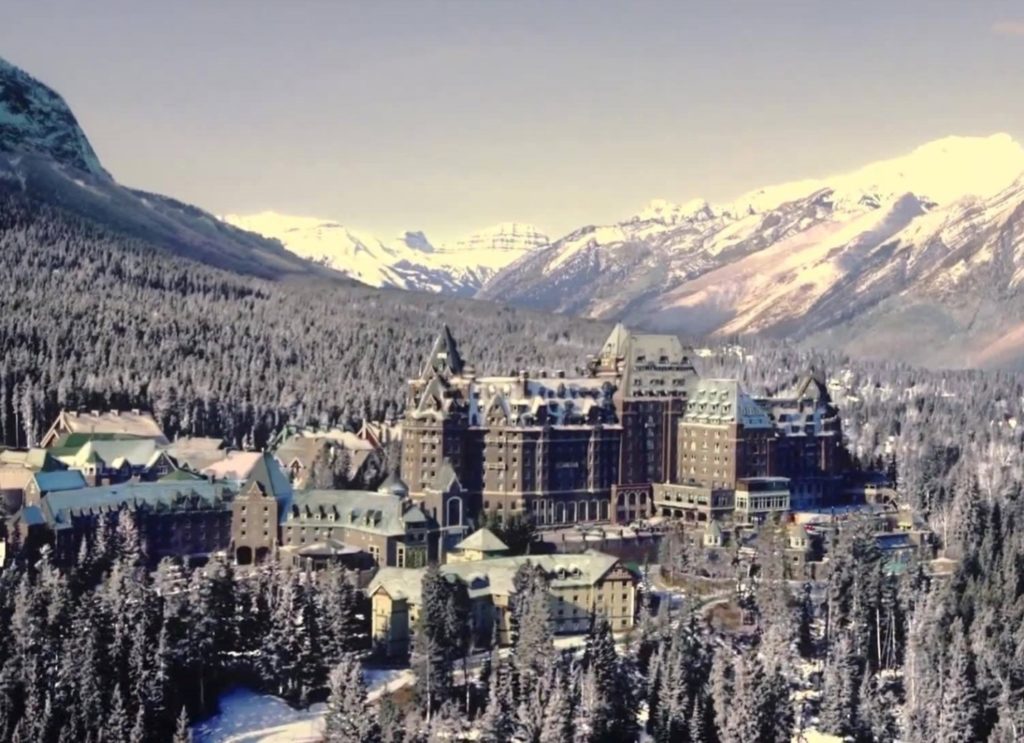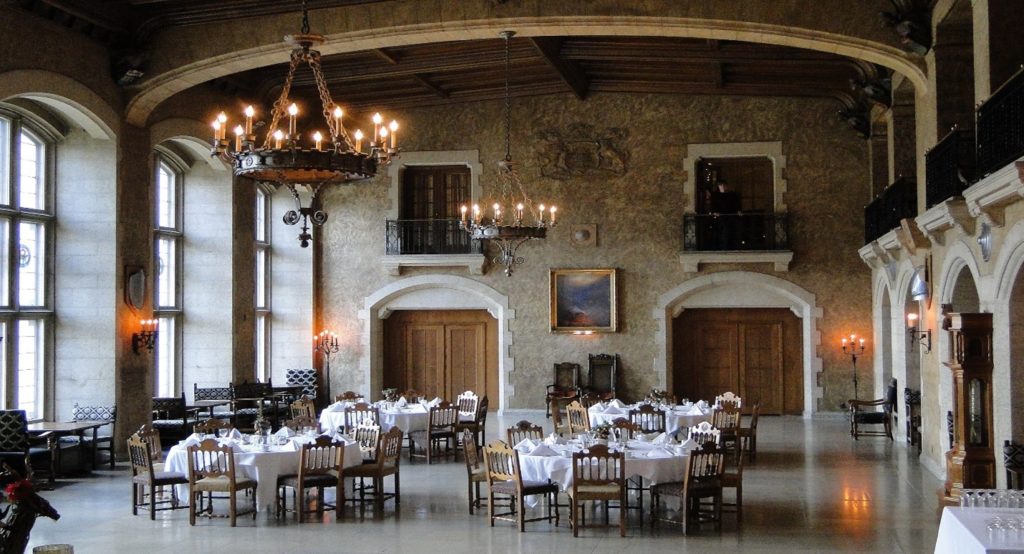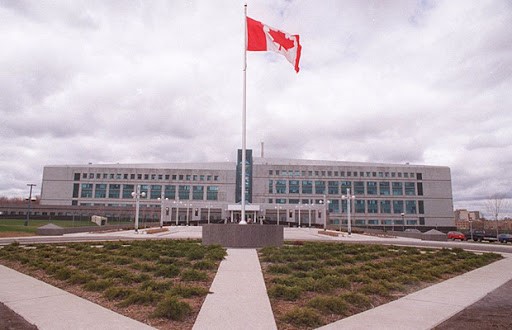

Author: Kent Moors, Ph.D.
This entry in the Classified Intelligence Brief “Spy Tales” series takes us just over the northern border.
Beginning in the 1870s, the Canadian Pacific Railway began building a series of famous grand luxury hotels to service its expanding clientele. The eight most famous are all Canadian national landmarks built in the European Château style, extending from Montreal in the east to Vancouver on the Pacific Ocean.
In 2007, I found myself at one of them, the exquisite Banff Springs Hotel (now a Fairmont). The hotel is world famous and is situated on the southern point of the alpine village of Banff, west of Calgary, Alberta.


The scenery provided by the Canadian Rockies is spectacular. Located in the heart of Banff National Park, a UNESCO World Heritage Site, what has been called Canada’s “Castle in the Rockies,” has been around since 1885.
You can play a round at the hotel’s golf course laying by towering peaks.


But keep in mind two considerations. The course is among the most expensive in Canada. And then there are the unique “natural hazards.” The entire area is populated by large herds of elk. You upon occasion need to shoot around them.


By the time I traveled there to address a global business conference on the sustainability of oil prices in a volatile market, I had become a recognized international expert in energy and geopolitical risk. My university had established its well-known Institute on Energy and the Environment, at which I would serve as chairman and scholar in residence until my retirement from academe at the end of 2013. That put me on an even more hectic lecture circuit.
Of course, all of this was part of my “day job.” This particular speaking engagement was also a carryover from a briefing I gave at a session of the British Institute of Energy Economics, meeting at St. John’s College, University of Oxford, about six months earlier. Some of the same participants gathered in Banff along with corporate and government leaders. The kernel of the group became a close-knit entourage who had come to know each other well. Several of them are members of my current network of global contacts on investment and risk matters.


At Banff, there were two participants having a particular interest for an ongoing op from my other life. These guys had been at Oxford and a previous gathering in Germany (which I had not attended). Both were officially labeled as reps from Russian natural gas giant Gazprom’s oil subsidiary Gazprom Neft. But neither was on any Gazprom or Gazprom Neft public list of officers, executives, or employees.
I had also confirmed when we were at Oxford that they knew little about either oil or energy in general.
This is not unusual. Both main Russian intelligence agencies – the SVU, successor to the KGB First Chief Directorate and having the responsibility for foreign espionage (the FSB is the new KGB Second Chief Directorate responsible for intel inside Russia), and the GRU, a branch of the Military General Staff and the largest Russian intel agency – would often use company, media (especially wire service TASS and Russian TV abroad), academic, and other designations as cover.
It is GRU not KGB/SVR that is assigned the task for intellectual and industrial espionage. If a Russian entity has hacked a foreign company’s computers, it will almost always be connected to the GRU not the SVR. The same can be said for attempts to subvert elections abroad.
So, given what these two had been interested in discussing at the two previous gatherings, the assumption had been they were looking for (1) ways to obtain foreign technology specs (probably making them GRU) and/or (2) foreign corporate execs or other figures who could be compromised into becoming assets (making them more likely (SVR).
Either way, we needed to know what they were up to, identify the possible targets, and develop ways to limit what they had in mind.
Now this was taking place on Canadian soil. That meant liaison was necessary with the CSIS (Canadian Security Intelligence Service). The CSIS had emerged in 1984 as the country’s civilian intelligence agency, after the McDonald Commission concluded its predecessor (the security division of the Royal Canadian Mounted Police, RCMP) had conducted illegal activities largely involving the violation of civil rights. The RCMP continues to act as Canada’s domestic law enforcement agency (paralleling a combination of the FBI and local police in the states) but its intelligence gathering activities directed against indigenous, student, and political groups in the 1960s and early 1970s created a political firestorm.
At the same time, congressional committees were roasting the CIA south of the border for similar internal actions.
CSIS had been fully apprised of what we were up to at Banff, although they still needed to coordinate with the RCMP on domestic legal matters. I needed to avoid being sucked into a no win internal Canadian intel turf battle.
It did not help any that my CSIS contact at Banff was an extremely attractive blonde who looked like the actress Elke Sommer. She was very capable, but it has been my experience that an operation is always more difficult if a member consistently attracts attention. Despite trying her best to fit in, it was a problem throughout the five days in which I was at Banff.
What we were doing could best be labeled “stalking.” This required walking a tight rope. Being on the program, I was a known visible quantity. If I spent too much time with them, they might conclude I was an intel officer attempting to recruit. On the other hand, appearing to ignore them would make it difficult to accomplish the assignment.
Here, my CSIS contact was useful. Seems both these guys enjoyed spending time with her. But, once again, there was a downside. Had to avoid the Russians getting the wrong idea of her intentions altogether.
We had some on the ground support from a small joint team based at a hotel further up in the village. Their jobs were to maintain communications with home offices, research the backgrounds of everybody at the conference, what interests the opposition may have in any of them, who among the group carried security clearances from whom and over what.
The way the conference was set up made the operation both easier and more difficult. Easier because the hotel was closed during the conference for security reasons (among other things, the Prime Minister addressed the gathering as well as two federal ministers). That meant I was stuck viewing the Rockies from inside of the hotel but at least did not have to worry about where our persons of interest would go outside or who would be coming in to assist them.
The problems emerged from having to set up ad hoc coms with our team. The regular telephones were not secure and could not be used for anything much beyond brief coded exchanges. The CSIS also prevented any bugging of hotel rooms. It would have been an international incident had any devices been discovered during the meetings. If there were to be an emergency exchange, it would happen in person with one or more of our team under cover of a local cleaning company with work at the hotel.
Still, whatever the two fellows had in mind was not going to be rolled out at Banff. They were there to further their own activities, but the real impact would only be felt later. That gave me some leverage.
Two separate focuses emerged. In one, the target was an executive with a wandering eye from a Canadian oil company having government contracts. Our Russian friends seemed intent on using a “honey trap” (placing a subject in a compromising sexual situation) to blackmail the executive. That seemed to be set up for action back closer to the company’s headquarters in Calgary.
The CSIS handled it from there. The company was advised of a potential security breach at Banff (but not the particulars). The executive in question was reassigned (actually promoted, but out of the policy line of interest to the Russians).
The second was more interesting, at least to me.
At the time, there had been a noticeable increase in Russian (and, for that matter, Chinese) interest in either acquiring outright or significant ownership in Canadian-based energy companies. Initiatives were being undertaken by both Russian major state-held companies (i.e., Rosneft, Gazprom, LUKoil, Surgutneftegaz) and foreign investment shells controlled by Moscow to move on Canadian exchange traded shares in advance of a concerted move to make offers.
Now this was more difficult. Canadian policy does not prevent domestic energy companies from being acquired by foreign corporations. Nonetheless, this could constitute a major security problem if it turned out that domestic (or, for that matter, North American) energy needs suddenly became dependent on the political whims of a foreign state.
Our move here required early detection of likely stock moves on the Toronto and Vancouver exchanges following upon each side bar meeting held by the Russians at Banff. There, the team up the street handled things nicely.
Over the next year, there were four moves against Canadian-based energy companies by Russian-sourced money. In each instance, CSIS had advised the companies before hand and the companies had revised internal bylaws to make controlling acquisition from outside the country very difficult (and more expensive).
Subsequently, Russian interests gained equity positions in three of the entities, but in no case controlled more than 15 percent of outstanding shares.
It was easier for CSIS to move in such matters because Canadian law allows it to provide intelligence assistance to domestic companies experiencing pressure from or involved in negotiating against foreign competitors.
The US remains the only major country not to provide a similar service to American corporations. The CIA is legally enjoined from doing so.
As for the Canadian Elke Sommer, Marina and I last heard from her via a Christmas card in 2019. She is married with two children and apparently out of the “great game.” According to the message, she is now a VP for a bank in Ottawa.
But old habits die hard. I have thus far resisted the temptation to compare how close the bank is located to 941 Ogilvie Road in the near-in Ottawa suburb of Gloucester. That is the address of this building:




This is an installment of Classified Intelligence Brief, your guide to what’s really happening behind the headlines… and how to profit from it. Dr. Kent Moors served the United States for 30 years as one of the most highly decorated intelligence operatives alive today (including THREE Presidential commendations).
After moving through the inner circles of royalty, oligarchs, billionaires, and the uber-rich, he discovered some of the most important secrets regarding finance, geo-politics, and business. As a result, he built one of the most impressive rolodexes in the world. His insights and network of contacts took him from a Vietnam veteran to becoming one of the globe’s most sought after consultants, with clients including six of the largest energy companies and the United States government.
Now, Dr. Moors is sharing his proprietary research every week… knowledge filtered through his decades as an internationally recognized professor and scholar, intelligence operative, business consultant, investor, and geo-political “troubleshooter.” This publication is designed to give you an insider’s view of what is really happening on the geo-political stage.
You can sign up for FREE to Classified Intelligence Brief and begin receiving insights from Dr. Moors and his team immediately.
Just click here – https://classifiedintelligencebrief.com/






